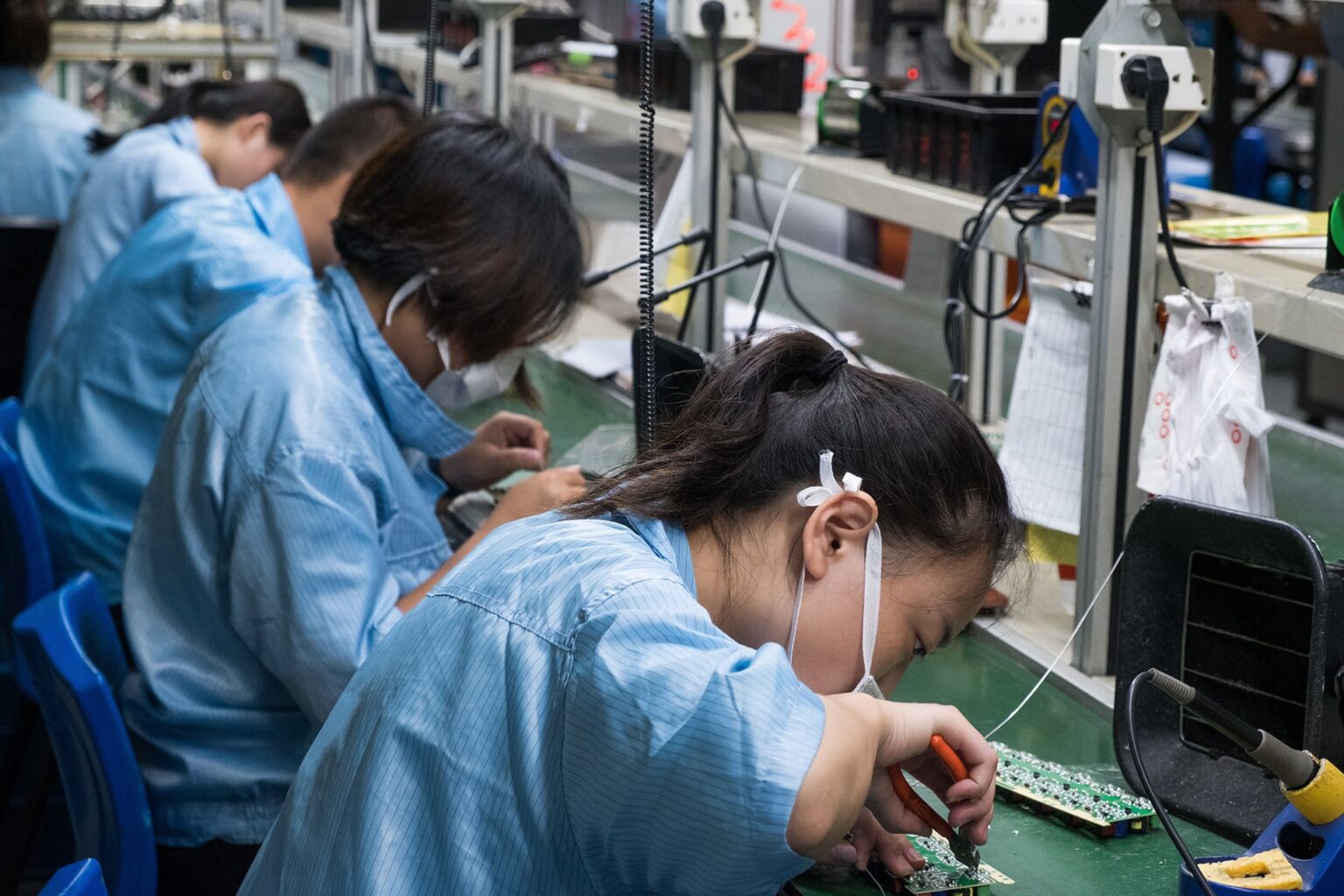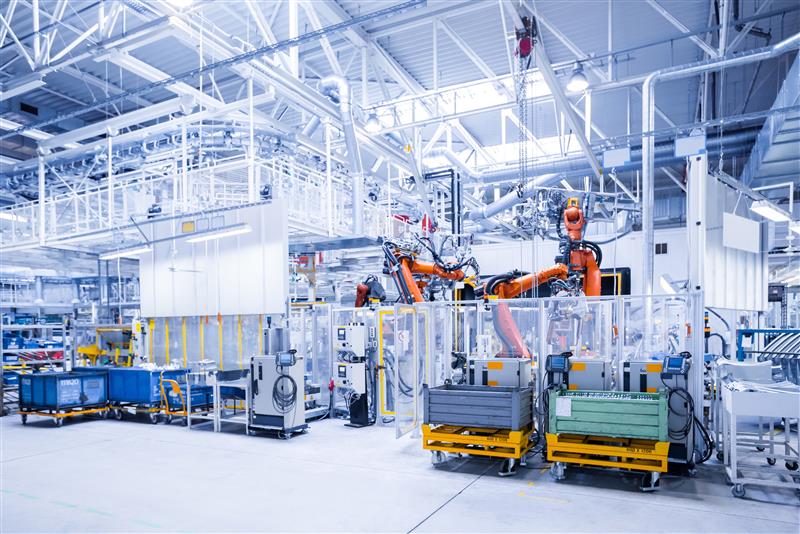As more organizations look to compete on the world stage, contract manufacturing remains a viable and enticing business opportunity. Not only can it reduce costs, but it’s a tremendously flexible alternative to in-house production.
Although decades old, the global industry is poised for a promising future — in fact, it’s on pace to reach $1018 billion by 2032. To put this in perspective, that’s double the size it was in 2023.
But what is contract manufacturing? How could it benefit your business? And, most importantly, what does it take to maximize its advantages to their full potential?
In this guide, we’ll answer all these questions and more. Read on to learn everything you need to know about contract manufacturing and how to optimize it with on-demand workforce solutions.
What Is Contract Manufacturing?
Contract manufacturing is a business arrangement in which an organization, typically a start-up or an original equipment manufacturer (OEM), outsources the production process to a third party. This entity is known as the contract manufacturer (CM) — a company that specializes in building products for other organizations.
Sometimes, the OEM completes most, if not all, of the product design internally. The contracting company receives this design and begins the product manufacturing process according to its specifications. After product development and production are complete, the CM delivers the finished goods to the hiring company, which takes them to market under its own brand name.
What’s the difference between contract and offshore manufacturing?
Contract manufacturing is often associated with similar terms like outsourcing and offshore manufacturing, but they’re not exactly the same. In short, outsourcing is a broader term that can include any task or operation that’s contracted out to another business. So, contract manufacturing work is just one form of outsourcing.
Likewise, offshore manufacturing is a type of contracted or outsourced manufacturing. The only difference? The contracting company operates in a foreign country, like Vietnam, China, India, or Taiwan. OEMs typically work with an offshore manufacturing organization to take advantage of lower labor costs and favorable economic conditions.
How does contract manufacturing work?
The original equipment manufacturer begins by finalizing the product design. This includes detailed specifications, drawings, and potential prototypes. Once this is complete, the OEM evaluates various contracting companies based on numerous factors, such as their:
- Ability to produce at the requisite quality levels.
- Capacity to scale production volumes according to demand.
- Experience in the industry or with similar products.
- Compliance with relevant regulatory standards.

After choosing a CM, the parties negotiate a manufacturing agreement. This contract covers pricing, intellectual property rights, quality expectations, timelines, logistics, and other details relevant to the production process. These terms establish the Manufacturing Services Agreement (MSA) between the hiring company and the contract manufacturer.
Next, the work begins. This typically involves component and equipment purchasing, detailed production line layouts, direct and indirect labor hiring and training, and a trial production run. Once approved by the hiring company, the CM proceeds to mass production. This cycle will repeat until the agreement is either completed or terminated.
Examples of contract manufacturing
Industries of all shapes and sizes leverage outsourced manufacturing to their advantage.
An excellent example is the consumer electronics industry. Many tech giants use “electronic manufacturing services” (EMS). Simply put, it’s a form of contract manufacturing focusing specifically on electronic products, like tablets, smartphones, computers, etc.
In fact, as of 2022, over 90% of Apple products were manufactured in China. Outsourcing production allows OEMs like Apple or Samsung to focus on research and development — an increasingly necessary advantage in a highly competitive industry.
Why outsource the manufacturing process?

There are many reasons you might consider contract manufacturing. According to a 2023 survey, the most cited factor in deciding to outsource manufacturing is a lack of resources/expertise. That’s followed by the ability to focus on other priorities, supply chain stability, and cost savings.
Indeed, this approach is best suited for companies concerned with:
- High start-up costs: In-house operations require large upfront investments, especially for new OEMs. Manufacturing equipment, supplies, materials, and labor are sizable expenses, not to mention the cost of ongoing production. By contrast, contract manufacturing services offer a way to bypass these barriers, as there’s no need to purchase machinery, real estate, and other resources.
- Lack of capital: Likewise, if your company is stuck in a particular growth stage, you may not have capital available to scale upwards. Outsourcing the manufacturing operation to a CM can free valuable resources, which you can flexibly invest in other areas of your business.
- Faster market entry: If you’re worried about lead times, working with a CM can accelerate time-to-value. By scaling production volumes accordingly, they’ll help you bring products to market (and even beat competitors to the finish line).
- Lack of expertise: Contract manufacturing services aren’t just for big enterprises. Smaller organizations may not have the in-house expertise to manage product development, but contracting companies provide access to the necessary skill sets.
- Facility constraints: Owning and operating a manufacturing facility is expensive. Even worse, they’re limited by physical space, which means you can’t easily scale production up or down. This can lead to wasted resources or an inability to meet forecasted demand.
Types of Contract Manufacturing
A contract manufacturing relationship ultimately depends on the details of the manufacturing contract. Its terms dictate the services the CM provides, which can range from fairly minimal to comprehensive.
However, there are three most common types of CM arrangements:
1. OEM vs. Original design manufacturing (ODM)
Typically, the contract manufacturer produces products according to specifications provided by the OEM. The OEM retains ownership of the product design and brand, ensuring they control the marketing, branding, and final distribution. This model is typical for companies that design their products but outsource the manufacturing process to capitalize on the CM’s production capabilities and cost efficiencies.
Original design manufacturing (ODM) goes a step further. In this scenario, the ODM partner not only manufactures the finished product but also designs it under the guidance and requirements of the contracting company. Once produced, these products can be branded and sold under different company names. This is ideal for companies that want to market a product but don’t wish to handle the complexities of the product design and development processes.
2. Individual component manufacturing
In this case, the CM produces just one component or part of a more complex final product. OEMs might choose this route if they want to outsource a particular aspect of the product design but retain control over the rest of it.
Alternatively, they could contract an additional manufacturing company to produce the remaining parts. Either way, the OEM is ultimately responsible for assembling the end product.

3. Labor subcontracting
Similar to the previous approach, labor subcontracting involves just one aspect of the production process — not the entire cycle. Here, a general contractor hires a secondary company to perform specific tasks or jobs as part of a larger project. This arrangement allows the contractor to focus on core competencies, manage project costs more effectively, and leverage specialized skills without the need for permanent hires.
Benefits of Contract Manufacturing
Working with a contract manufacturing company has its advantages. Let’s take a closer look at three key areas it can make the greatest impact:
Cost optimization
By outsourcing production, you can avoid the expenses associated with operating a manufacturing facility, such as utilities, maintenance, and labor costs. Additionally, CMs often have economies of scale which allow them to purchase raw materials at a lower price, spreading their fixed costs across multiple clients, further reducing the per-unit cost of production for OEMs.
Plus, with a third party, you can strategically outsource work to a different country or region where labor, taxes, raw materials, and energy are less expensive. Moreover, pivoting from a fixed-cost to a variable-cost model frees up capital, which can be advantageous when facing supply chain disruptions.
Flexibility and business agility
Contract manufacturing provides the flexibility to easily adjust production volumes without the risks and fixed costs of operating your own factory. You can ramp up or scale down production quickly and efficiently in response to consumer demand or market trends. This agility ensures that you can respond to opportunities and challenges more effectively, minimizing the risk of overproduction or stockouts.
Operational efficiency
Outsourcing production to contract manufacturers allows you to leverage specialized expertise and advanced technologies without needing to invest in and maintain them internally. Contract manufacturers often have optimized production processes, state-of-the-art equipment, and a skilled workforce that can produce high-quality products efficiently.
This setup enables OEMs to focus on their core competencies, such as product innovation and brand development, while leaving the complexities of day-to-day manufacturing operations to experienced providers. This enhances operational efficiency, enables faster turnaround times, and increases product quality, which can lead to increased customer satisfaction and competitive advantage.
Contract Manufacturing Challenges
Despite its pros, contract manufacturing has its cons, too. Common obstacles you might encounter include:
Quality control
Let’s say you’re based in the United States, but you outsource manufacturing overseas. If you don’t have eyes on the production process, how can you ensure the CM is meeting your standards? Without checks and balances, some partners may let quality fall by the wayside.

That’s why it pays dividends to have a reliable third-party expert on location, seeing to it your standards are upheld. Factory audits, for example, can uncover and address operational inefficiencies, quality gaps, and other issues.
Intellectual property (IP)
Entrusting production to a third party can expose you to risks related to IP theft or misuse, especially in countries with less stringent IP protection laws. Safeguarding proprietary designs, formulations, and trade secrets is critical when entering contract manufacturing agreements. OEMs need to implement robust confidentiality agreements and choose partners with a solid reputation for respecting IP rights.
Supply chain management
Contract manufacturing can add layers of complexity to the supply chain, making logistics management more challenging. Coordinating between multiple suppliers, manufacturers, and distribution systems can lead to inefficiencies and increased costs. Managing this requires sophisticated supply chain strategies and might necessitate using advanced software systems for integration and oversight.
Communication challenges
Effective communication is crucial in any business relationship, but it can be particularly challenging in contract manufacturing due to geographical distances, language barriers, and cultural differences.
Misunderstandings and miscommunications can lead to errors, delays, and frustrations on both sides. Establishing clear communication channels and protocols is essential, and sometimes this may involve intermediaries or local liaisons to ensure smooth interactions.
Overdependence
Relying on a third-party manufacturer means that OEMs often have less control over the manufacturing process. This dependency can be risky, particularly if the contract manufacturer faces disruptions, financial difficulties, or management changes. Building a diversified portfolio of manufacturing partners or having contingency plans in place can help mitigate these risks.
Choosing the Right Contract Manufacturer
Picking a partner isn’t easy, but there are steps you can follow to make the best decision. Here’s a 10-point checklist to set you off in the right direction:
- Reputation and experience: Research the manufacturer’s reputation in the industry. How long have they been in business? Do they have experience working with companies similar to yours? What practices are in place to protect your IP?
- Quality assurance and compliance: Review their quality control processes and certifications. Are they ISO-certified or compliant with other industry standards? Do they have a track record of producing high-quality products?
- Capacity and scalability: Assess their production capacity and ability to scale up or down according to your needs. Can they accommodate your current and future production requirements?
- Technological capabilities: Evaluate the manufacturer’s technological capabilities and equipment. Do they have the necessary machinery and expertise to produce your product efficiently?
- Cost and pricing structure: Obtain detailed quotes and analyze their pricing structure. Consider not only the initial cost but also any additional fees or hidden charges.
- Location and logistics: Consider the manufacturer’s location in relation to your distribution channels and target markets. Is their location convenient for shipping and logistics?
- Communication and collaboration: Evaluate their communication processes and responsiveness. Will they provide regular updates on production progress? Are they willing to collaborate closely with your team?
- Flexibility and customization: Determine if the manufacturer can accommodate customization and flexibility in production processes. Can they adapt to changes in product specifications or design?
- Supply chain management: Assess their supply chain management practices and personnel. Do they have reliable suppliers for raw materials? Do they have supply chain experts on-site to oversee and manage your project? Are they able to mitigate risks such as disruptions or shortages?
- References and reviews: Seek references from past or current clients and read reviews or testimonials. What do other companies say about their experiences working with this manufacturer?
After narrowing down choices, initiate formal discussions by sending a Request for Proposal (RFP) to at least three top contenders. Ensure a signed Non-Disclosure Agreement (NDA) is in place. Evaluate itemized quotes, warranty details, payment terms, and contracts to make informed decisions.

If this all sounds intensive, don’t worry — we’re here to help. Instead of going through it alone, SCRG’s supplier selection process will simplify the effort from start to finish. With a global database, local expertise, and years of experience, we’ll connect you to the ideal partner for your exact business needs.
How To Optimize Contract Manufacturing
Ultimately, most contract manufacturing challenges trace back to one root cause: a lack of visibility. Without the right people on location, it’s almost impossible to keep production running smoothly.
That’s why expert oversight is the best way to optimize CM and mitigate its challenges. By strategically placing talent at key points in the process, you can ensure partners maintain the standards and expectations agreed upon in your MSA.
The only problem? It’s costly to send your employees overseas. They may not have the requisite skills, speak the local language, or know the territory well enough.
Fortunately, that’s where a solution like Talent on Demand can help. As a staff augmentation model, you can leverage skilled personnel as your eyes and ears on the ground, who can monitor production, maintain quality, reduce lead times, and protect IP overseas.

In other words, it allows you to hire local experts without adding them to your permanent payroll. We take the burden of recruiting, hiring, training, and compensating employees off your shoulders, allowing you to worry less about liabilities, compliance, taxes, and more.
Our strategic workforce solutions cover all stages of the product manufacturing life cycle, with engineering talent in many of the world’s hottest manufacturing hubs. We deploy English-speaking experts in key roles, including:
- Supply chain managers.
- Project managers.
- Supplier quality engineers.
- Sustaining technical managers.
- Operation program managers.
- Test engineers.
- … and more.
When does it make sense to harness Talent on Demand? The use cases are numerous. Whether you’re onboarding a new CM, ramping up to mass production, or course-correcting an underperforming partner, it can offer the expertise you need in a matter of weeks.
All told, our specialists help you streamline operations, maximize efficiencies, and optimize your contract manufacturing processes. The result? Fewer offshore risks and more value from top to bottom.
Harness the Power of World-Class Talent
Is your organization ready to embrace the benefits of contract manufacturing? Don’t leave it to chance.
Contact us to augment your team with offshore engineering talent today.
